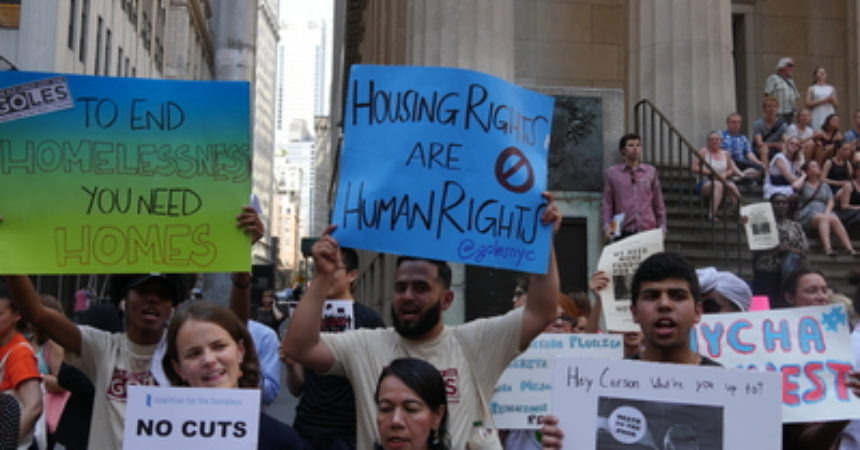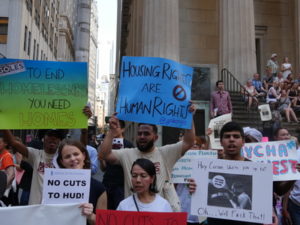
White House budget proposal cuts $8.6 billion from HUD
Programs serving low-and-moderate income consumers to end or suffer cuts
By Charlene Crowell
TriceEdneyWire.com
Once again, the White House Budget Proposal slashes funding and programs that many low-and-moderate income consumers rely upon.
From higher education to a repeated attack to deny the Consumer Financial Protection Bureau its full funding and financial independence from the annual congressional appropriations process, efforts to increase support to businesses continue while retreats from programs that citizens have come to rely upon is the crux of the proposal’s fiscal priorities.
And among federal agencies, one of the most severe budget cuts would occur at the Department of Housing and Urban Development (HUD). A proposed 15 percent reduction from current funding levels will mean $8.6 billion would either eliminate or severely cut programs serving many of the nation’s most vulnerable citizens and communities.
“This Budget advances our key priorities, including empowering HUD-assisted families to achieve self-sufficiency,” HUD Secretary Ben Carson said. “For generations, the idea of the federal government providing housing assistance meant only one thing—helping to pay the rent so families can have a roof over their heads.”

People of low and moderate income across the country have been protesting cuts to HUD programs.
Photo special to the Outlook
Housing experts have a different perspective.
“With this proposal, President Trump and Secretary Carson make clear their willingness to increase evictions and homelessness – through rent hikes for some of the lowest income people in subsidized housing, and slashing or eliminating funding for programs that keep the poorest people in our country in affordably and safely housed,” said Diane Yentel, President and CEO of the National Low Income Housing Coalition.
For example, Public Housing’s Capital Improvement Fund that provides revenues for major repairs, would end, while the Public Housing Operating Fund would be slashed 21 percent. Together, these two cuts would worsen housing conditions for the estimated 1.2 million households living in public housing units, managed by some 3,300 local Housing Authorities across the country.
The biggest portion of the HUD cuts would end the $3.3 billion Community Development Block Grant (CDBG) program that uses a formula to support over 1,200 metropolitan city, county and state governments. An additional 214 counties receive direct CDBG grants.
Since Beginning in 1974, CDBG has earned longstanding bipartisan praise for its ability to lure much-needed private investment. According to the National Association of Counties, every CDBG dollar leverages $4.09 in non-CDBG revenues. Further, it is one of the few federal programs that enable local communities to design community development services that respond to local priorities and needs.
Other HUD programs proposed to end include: Choice Neighborhoods Initiatives, Veterans Affairs Supportive Housing Vouchers, Self-Help Homeownership Opportunity, and Housing Opportunities for Persons with AIDS (HOPWA).
Although HUD would not shutter its Fair Housing and Equal Opportunity efforts, its capacity to pursue equal housing would be cut 7 percent in FY2020. Tenant-based Rental Assistance would also have 21 percent fewer renewed contracts.
Even before the Feb. 10 budget proposal’s release, Lisa Rice, President and CEO of the National Fair Housing Alliance sounded an alarm on the heels of HUD’s announcement to abandon its rule promulgated during the Obama Administration, Affirmatively Furthering Fair Housing (AFFH).
“Access to fair housing determines where we live, which in turn determines the quality of education and health services our children have access to, among other resources. That’s why HUD’s proposed AFFH rule is so troubling,” said Rice. “By seeking to dismantle the 2015 requirements put in place specifically to address discrimination and segregation, HUD’s plan could negatively impact the lives of millions of children.”
Nikitra Bailey, an EVP with the Center for Responsible Lending also spoke out about HUD’s troubling actions against fair housing.
“The 2015 AFFH rule was designed to address the impact of residential segregation and the harmful inequities that result from the discrimination behind it. Discrimination in housing is not a thing of the past, it is ongoing and real,” noted Bailey. “Low-income communities and communities of color now more than ever need the government to provide them with critical tools to combat discrimination in housing and the insidious harms that result. Instead we’ve seen HUD, under the current Administration, do the opposite.”
Hannah Matthews, Deputy Executive Director for Policy with the Center for Law and Social Policy (CLASP), a national, nonpartisan, nonprofit organization advancing policy solutions for low-income people pointedly summarized the budget proposal.
“The roadmap laid out in the administration’s budget proposal is not a viable path forward,” said Matthews. “Instead, we need a federal budget that invests in America’s future. We need investments that reduce poverty, promote economic opportunity, and reduce racial and ethnic disparities.”







